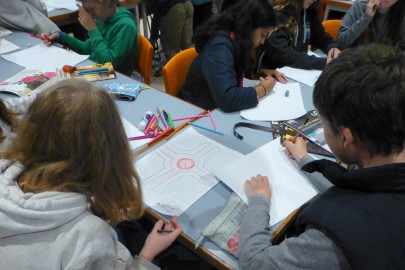Rudolf Steiner School, Christchurch
In this section
-
Participating schools
- Curious Minds visit Lincoln
- Franz Josef & Fox Glacier Schools
- Greymouth High School
- Haast School
- Halswell Domain
- Halswell School
- Heathcote Valley School
- Kaniere School
- Kaniere visit Lincoln
- Hokitika Primary
- Leeston Consolidated School
- Manuka Primary School
- Mission Heights
- Mt Albert Grammar
- Paroa School
- Rudolf Steiner School
- Takapuna Grammar
- TKKM
- Wakaaranga Primary School
- Whataroa School

Rudolf Steiner School students designing their 'dream gardens'. Image: Murray Dawson
The visit was made just before the start of Term 1 school holidays, so we were fortunate that the school could fit us in.
The Christchurch Rudolf Steiner School has a roll of about 400 students, comprising a kindergarten, primary and secondary school. The school was founded in 1975 and became a state-funded integrated school in 1989. As stated on their website, they balance a Steiner curriculum with all the achievement objectives the New Zealand Curriculum Framework.
36 Year 9–10 students joined us for a couple of hours, supported by teachers Katrina Burns and Paris Bronte and a teacher aide. Teachers Peter Oliver and Roger Clark also called in to see what we were doing. As it turned out, two of the teachers and one student has close ties with MWLR, proving that it's a small world!
During our time together, we packed in a range of in-class activities learning about weeds, how they disperse and how to identify them. Murray brought in a range of locally collected environmental weeds to pass around and discuss, and we used a smartphone interactive key to identify them.
Although the class was too large and there was not enough time for the students to use the iNaturalist app outdoors, Murray returned during their holidays and recorded >90 cultivated and weedy plants in the area, as part of 2019 City Nature Challenge, involving 159 cities from around the world. During the four-day challenge, 320 Christchurch observers recorded >2,300 species from >17,500 observations.
What were some of the plants that we found?
The school grounds are beautifully planted and include a large and well-tended organic fruit and vegetable garden.
There was an extensive range of lovely native plantings including:
- Akeake (Dodonaea viscosa)
- Brachyglottis greyi
- Coprosma hybrids and species
- Five finger (Pseudopanax arboreus)
- Golden tōtara (Podocarpus totara ‘Aurea’)
- Gossamer grass (Anemanthele lessoniana)
- Hebes (Veronica selections)
- Kōwhai (Sophora tetraptera)
- Lancewood (Pseudopanax crassifolius)
- Lowland ribbonwood (Plagianthus regius)
- Mamaku (Cyathea medullaris)
- NZ cabbage tree (Cordyline australis)
- Pittosporums (P. crassifolium and P. eugenioides)
- Rengarenga (Arthropodium cirratum)
- Shrubby tororaro (Muehlenbeckia astonii)
- Wharariki (Phormium cookianum) and some ornamental NZ flax cultivars.
It was a treat to see kākā-beak (Clianthus maximus), a rare and cold-tender native plant growing against a sheltered wall. Some native plants were observed self-establishing in the area, such as akeake, lowland ribbonwood and poroporo.
Exotic tree plantings included:
- Chestnut (Castanea sativa)
- Lawson’s cypress (Chamaecyparis lawsoniana)
- Olive (Olea europaea)
- Princess tree (Paulownia tomentosa)
- Silver birch (Betula pendula).
A line of tall poplar trees (Populus nigra) provided a dramatic avenue to one of the school entrances. In the organic garden, a loquat (Eriobotrya japonica) fruit tree was seen which is another rarity in the Canterbury climate.
There was a great range of showy exotic herbaceous plants too, which were allowed to establish around the school grounds, cottage garden style. These included abutilons (Callianthe picta), hollyhocks (Alcea rosea), and the especially dramatic giant viper’s-bugloss (Echium pininana).
All in all, a very interesting place to botanise!

Funding
This was the last in-school visit funded by the 2018/19 Curious Minds MBIE Participatory Science Platform (PSP) and The Brian Mason Scientific & Technical Trust. Both funders kindly allowed us to extend our delivery from 2018 into the first quarter of 2019.
